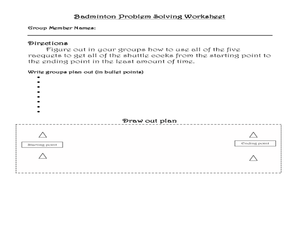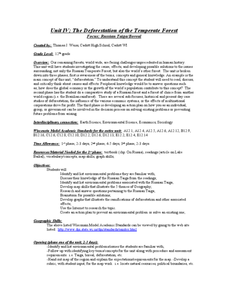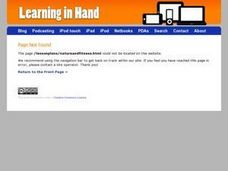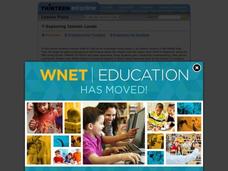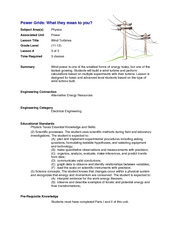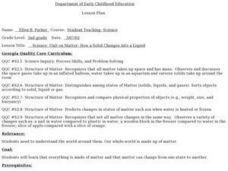Curated OER
How Much Do I Know About Water?
Sixth graders explore how water behaves on a penny. In this states of matter lesson, 6th graders observe water as they add drops to a penny. This lesson helps students apply the adhesive properties of water to the water cycle.
Curated OER
Something's Fishy
Fourth graders identify parts of a fish. In this fish anatomy lesson, 4th graders identify parts of fish in a group setting and then complete a worksheet about the parts of a fish.
Curated OER
The Case of the Missing Water
Students examine the major concepts related to the water cycle in this lesson. They recognize and define evaporation, condensation, precipitation and the natural cycles that occur as weather. They also participate in an activity of...
Curated OER
Elements and Compounds
Students explain how radioactive decay occurs. In this physical science lesson, students simulate radioactive half-life through an experiment. They graph their data and share their results in class.
Curated OER
Detecting Meteors by Radio in the Classroom
Twelfth graders describe and interpret the science of optical and radio telescopes, space probes and remote sensing technologies (Unit E) They explain the role of radio and optical telescopes in determining characteristics of stars and...
Curated OER
Sports and Exercise Activity
Eighth graders practice utilizing motor skills by participating in different sports activities. In this physical education lesson, 8th graders participate in racquetball, shuttle cock, and baseball style activities in order to...
Curated OER
TE Activity: Testing Fundamental Loads
Students experiment with the five fundamental load types that can act on structures. They use foam insulation blocks to which they apply the forces and draw the fracture patterns. They determine the telltale marks of failure that is...
Curated OER
Carbon Footprint Estimator
Students discover what a Carbon Footprint represents. In this sustainable lifestyle lesson, students determine their Carbon Footprint as an individual and as a class. Students use a the Internet to calculate how many earths it would...
Curated OER
Pesticides in Schools
Students investigate the practices their school uses for pest control. Depending on their findings, students may suggest alternative, non-chemical methods. They present a pest control plan to school officials. Great, real life...
Curated OER
Red Mangroves Of Southern Florida
Students engage in a unit plan to examine the ecological background for the Mangroves of southern Florida. They conduct research using print and computer technology sources. They use the information in a number of other extension...
Curated OER
The Deforestation of the Temperate Forest Focus; Russian Taiga/Boreal
Twelfth graders complete a unit of lessons on the Russian Temperate Forest. They list the environmental problems associated with deforestation, conduct research, compare the Russian Taiga with other forests, create graphs, and develop an...
Curated OER
Nature and Fintess Trail
Students investigate how humans impact the environment and compile an organism database into an e-book field guide. They name muscle groups and develop specific exercises to strengthen these groups. Students utilize technology for data...
Curated OER
Wave Properties
Students identify how waves transfer energy without transferring matter. They contrast transverse and compressional waves and relate wave speed, wavelength, amplitude and frequency. Lesson includes PowerPoint presentation.
Curated OER
Exploring Islamic Lands
Students examine the lives of Islamic teens. In this global studies lesson, students explore selected Internet sites to discover the attributes of Islam, the cultural traditions of Islam, and information regarding Middle Eastern...
Curated OER
Curious Clouds
Second graders explore clouds. They read The Cloud Book by Tomie dePola. Students sort the cloud pictures into three categories. Students create a graph using the cloud pictures. They use Excel to create a bar graph.
Curated OER
Social Studies: Bathroom Vandalism
Young scholars research vandalism of bathrooms in various schools. they survey students, janitors, and school administrators about their views on vandalism and how to prevent it. Young scholars then develop a plan to solve the graffiti...
Curated OER
Taking Action
Students use the net they make to dip macroinvertebrates at or below the surface. The flat side of the net allows pressure on the substrate so that organisms do not escape under the net. Two students hold onto the handles and submerge...
Curated OER
Restaurants and Institutional Examination 4
Match the vocabulary terms in column A with the definitions in column B. Write the letter of the definition in column B in the space next to the terms in column A.Write short answers or fill in the blank to the following questions and...
Curated OER
Women in Science
Learners examine obstacles faced by women throughout the world. They gather ask-an-expert websites, propose leading questions, and communicate with real female scientists.
Curated OER
Wind Turbines
Students build their own wind turbine. In this physics instructional activity, students calculate the power output of their wind turbines. They evaluate their design and make the necessary modifications.
Curated OER
Science: Liquid Matter
Second graders examine the properties of liquids and their classifications. They compare and contrast cups of different liquids and record their findings in journals. Students observe how liquids flow at various speeds and that unlike...
Curated OER
Science-Unit on Matter-Gases
First graders understand that gases take up space even though you can't see or smell it. This is done through many experiments like trapping air in different sized bags, using balloons and plastic bottles, and blowing bubbles. They...
Curated OER
Science: How Solids Become Liquids
Second graders discover how matter changes from one state to another by observing melting ice cubes. They decide on means to warm the ice and predict what will happen. Students record how long it takes for the cubes to melt.
Curated OER
The History of Maple Syrup
Students explore the process of harvesting maple syrup. In this science and history lesson, students make their own maple syrup and create a picture book that shows the Native American and American pioneer methods of making the syrup.





